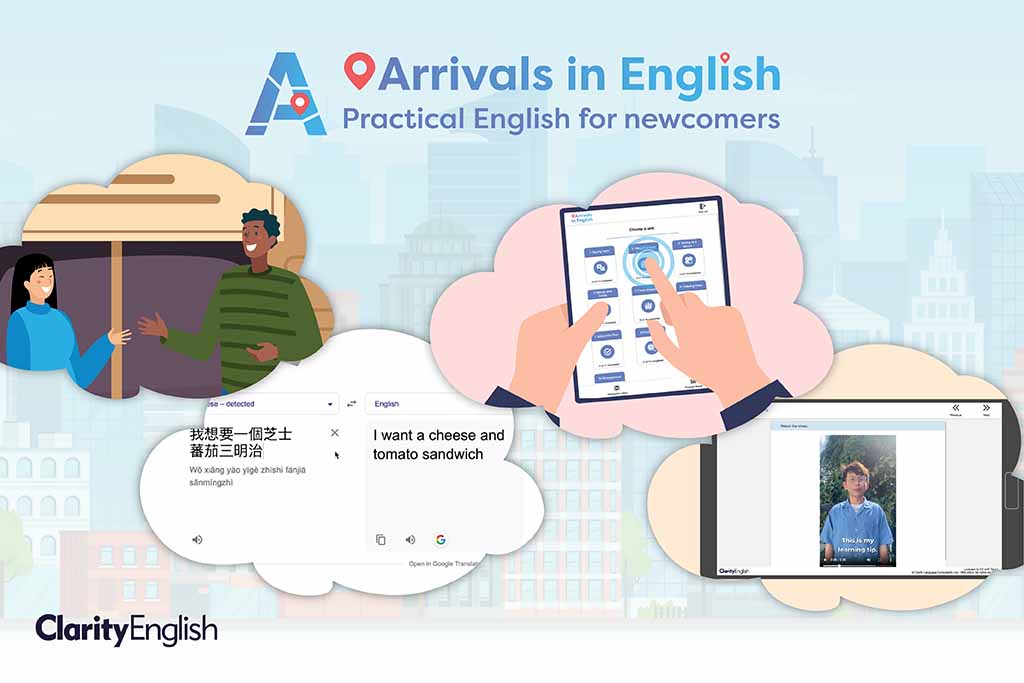Preliminary note: there are three versions of Arrivals in English which run parallel to each other – British English, Australian/New Zealand English, and Canadian English. The reviewer looked at the British English version.
Moving is stressful at the best of times. But relocating to a foreign country, where you are just beginning to learn the language, can be overwhelmingly difficult. Arrivals in English (British English version) sets out to equip newcomers to the UK (refugees, asylum seekers, dependants and migrants), with essential vocabulary and skills needed to be able to function and operate in their new community. After exploring the full program for the first time following its launch last month, I’ve put together a short review with my first impressions. Overall, it has the potential to be a genuinely useful tool to an underserved demographic.
Structure of the program
The program is introduced through non-verbal animated videos which illustrate the topics that will be covered. These videos are also seen at the start of every unit— removing the need for extensive written instructions.
Arrivals in English has 10 units which focus on specific topics such as filling in a form, applying for work, and talking to a doctor. Each unit has three sections:
- Practice: the bulk of the unit. This section starts with a video introducing a scenario, for example a toothache that requires the character to fill in a form to register for the local dental practice. This is immediately followed by essential vocabulary for the topic. Then over the next few exercises, the vocabulary is developed into functional phrases, ready for learners to use in real and practical situations.
- Vocab: this section covers additional vocabulary recognition and repetition. The content relates to the unit’s topic, and builds on that covered in the Practice section.
- Learning tools: this section helps users develop their learning skills away from the program and classroom — teaching efficient and effective ways to use free online tools like Google Translate and YouTube for language learning.
Technology and access
The program is available on all devices with an active internet connection: mobile, tablet, laptop and PC. This increases the accessibility of the program for learners that may be more comfortable and confident on their own mobile devices; learners that need to learn on the go; or learners that don’t have comprehensive digital skills or struggle with navigating a computer.
Due to the nature of the target audience and the environments in which the program may be used, it would be good to see a future version where units could be downloaded and worked on offline.
What works?
Written instructions are kept to a minimum and the exercises are fairly intuitive and immersive, which is what you would want for a beginner. Perhaps the program could do with a little more guidance after the first unit— keeping the “Help” videos accessible throughout the program would be especially useful for those learners that aren’t as confident with their digital skills.
The program moves away from the academic-focus of classroom language learning, to a more task-based environment which is more helpful to the target user. Arrivals in English has this question at the heart of it: what do I need in order to function in my new community?
With that central question, the program equips the learner with required vocabulary and functional language, and also helps to familiarise them with the tasks that they have to perform. For example, the learner can watch a video of someone going through an online booking process with an actual GP or someone doing an online grocery shop. Similarly, after filling in a form at the end of Unit 2, the learner is encouraged to save and download the completed exercise to use as a template to refer to in future real-life situations. These thoughtful details and additional localisations really make the program a useful and practical resource to help newcomers.
Arrivals in English will be a great resource to assist newcomers while they are on a waiting list to access English classes. It will also work nicely alongside ESOL classes as a resource that learners can work on independently outside of the classroom. Government research shows that English skills are critical to integration in UK society1. This program can be a useful tool in the first step to establishing a new home.
1Refugee Action, Let Refugees Learn, May 2016 Mhttps://www.refugee-action.org.uk/wp-content/uploads/2016/11/letrefugeeslearnfullreport.pdf

